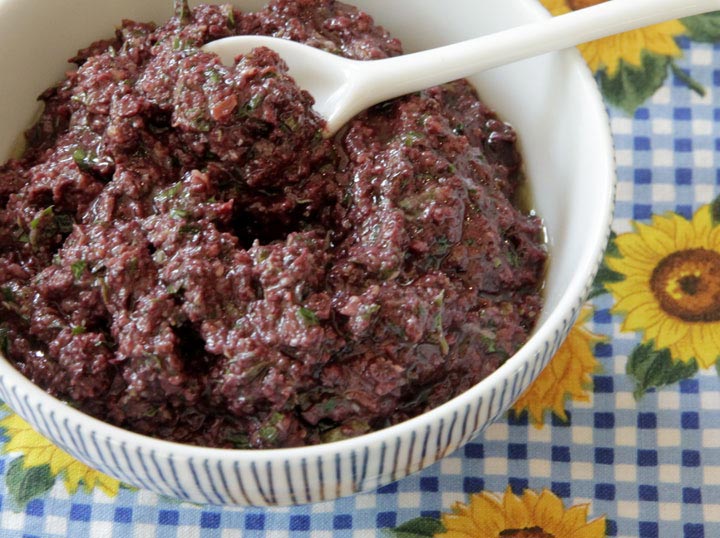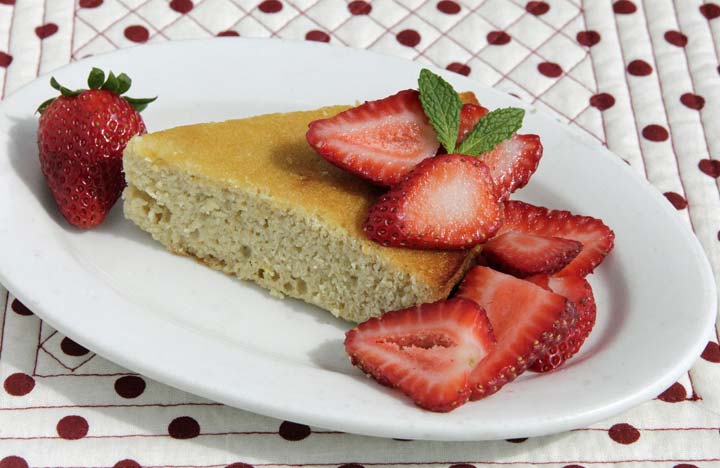
Tapenade
Tapenade is a condiment made with puréed or finely chopped olives, capers, anchovies, and olive oil. Its name comes from the French word for capers, tapenas. Well before the French fell in love with tapenade, the ancient Romans made olive-based tapenades with anchovies. Recipes were first found in Roman cuisine from the first century A.D.! Some foods seem to always satisfy.
Prep time: 15 min • Yield: A little over 1 cup
Equipment
- Food processor.
- 1 cup olives, i.e. Kalamata, Nicoise, or other black cured olive
- 1 tablespoon minced garlic
- 1 tablespoon capers
- 2 tablespoons freshly squeezed lemon juice
- 3 tablespoons fresh parsley leaves, chopped
- 1 tablespoon fresh marjoram, leaves only
- 1 tablespoon fresh thyme, leaves only
- 1 tablespoon anchovy paste, or 1 – 2 anchovy fillets rinsed
- 2 tablespoons cold pressed extra virgin olive oil
- Rinse the olives and capers in cool water.
- Put all ingredients in food processor and pulse, stopping to scrape down the sides, until the mixture is a coarse paste, about 1 – 2 minutes.
- Add olive oil and pulse to blend.
- Refrigerate in an airtight container for up to one week.
Notes and Tips: Tapenade is very popular in Provence where it is most often eaten as an hors d’oeuvre spread on bread, but here are a number of ways you can use it in your Paleo cooking: serve it with crudités, spread it on your burger, stuff a spoonful inside a chicken breast before you roast it, add it to a simple vinaigrette to dress your salad, put a dab on baked or broiled fish, add a dollop to your Greek salad, serve as a condiment with steak, add it to bison burgers, mix it into your breakfast omelet, or serve it in a simple salad of tomatoes, cucumbers, and onions, drizzled with a bit more olive oil.
Tapenade is a very salty condiment; a little goes a long way. If you are one who cringes at the thought of eating those little “hairy” anchovy fillets, leave them out, but they are tamed by the bold olive taste. I use anchovy paste because it takes forever to use a full can of anchovies, but anchovy paste lasts for months in the frig. This is one recipe where I believe you should use fresh herbs, not dried. Thyme can be tricky. Sometimes even fresh thyme has very hard, dry leaves. Unless they are tender, leave them out.
The woody texture ruins the soft smoothness of the tapenade. Marjoram is my favorite herb so I use it in tapenade, but you can’t always find it fresh. If you’re not familiar with marjoram, do try it. It has a sweet, soft, fragrant quality more delicate than oregano. You can play around with adding any number of flavors in your tapenade. Some recipes blend in a variety of olives and include green olives. I enjoy the sweetness of adding oven roasted tomatoes.
Chef and author, David Lebovitz, who worked with Alice Waters, the godmother of cooking with locally grown organics at Chez Panisse in Berkeley, adds a sweet note to his tapenade with figs. I tried adding ½ cup of pureed organic raisins I soaked overnight and found the sweetness to be a fine balance with the intense saltiness of the tapenade.







